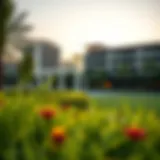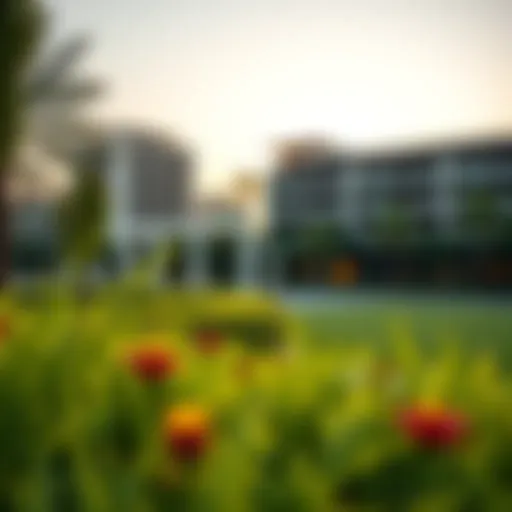Architectural Heritage of Old Houses in the UAE
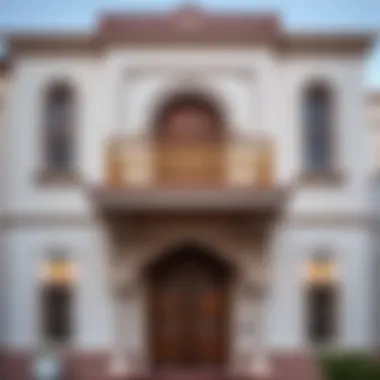

Intro
The architectural landscape of the United Arab Emirates is a fascinating mosaic, interwoven with hallowed traditions and modern aspirations. Old houses, standing as sentinels of the past, reflect the cultural essence and historical narratives that have shaped not only cities like Dubai and Abu Dhabi but the entire nation. Beneath the facades of these age-old structures lie tales of a simpler time, where lifestyle revolved around communal ties, local materials, and an environmental harmony that often eludes today's urban planning.
As we move through this exploration of architectural heritage, one can’t help but notice the intricate details embedded in the walls of these buildings. From wind towers that cleverly harness natural aeration to the distinct courtyard designs promoting family gatherings, each element has a purpose rooted in the region's climate and social customs.
The preservation of these old houses serves a dual role: it upholds cultural identity while also presenting a beacon for contemporary society. These buildings are not merely relics; they are living parts of the community, continually transitioning while maintaining their integrity. This journey will take us through the characteristics of traditional Emirati architecture, the historical contexts that birthed them, and how restoration efforts are presenting both challenges and opportunities to weave these stories into today's society.
"Old houses in the UAE are not just places to live; they are narratives etched in stone, telling stories of resilience and community through the ages."
Through this article, we will examine how these heritage sites contribute significantly to the UAE's identity, while simultaneously addressing the modern urban developments that threaten to overshadow them. Let us embark on this essential exploration of the architectural heritage that is as much a part of the UAE's future as it is of its past.
Historical Context of Emirati Architecture
Understanding the historical context of Emirati architecture is vital in grasping the intricate tapestry of cultural influences that shaped the design and construction of old houses in the UAE. This exploration not only emphasizes the enduring heritage but also contributes significantly to the current identity of Emirati society. The old houses provide a concrete reflection of the traditions, economic conditions, and social structures prevalent in various eras.
Roots of Traditional Architecture
Old Emirati houses have roots that stretch deep into the rich soil of the region's history. Their design reflects the needs of the community and their resilience to the harsh climatic conditions. Traditionally, the architecture employed natural materials like mud and palm fronds, which were locally sourced.
The falaj, an ancient irrigation system, shows that water management played a crucial role in establishing settlements. The homes were structured around communal life, promoting social connections that remain a hallmark of Emirati culture. In essence, these structures are more than mere dwellings; they stand as testimony to generations of ingenuity and adaptation.
Influence of Geography and Climate
The geography of the UAE significantly impacted its architectural styles. With vast deserts and adjacent coastlines, the materials and methods used were inherently devised to withstand extreme temperatures and environmental challenges. In coastal areas, homes often utilize coral stone due to its durability and insulating properties, while inland communities leaned towards adobe, which kept interiors cool during sweltering summer days.
Climate also deeply influenced the architectural features, like the prevalent use of wind towers or barjeel. These traditional ventilation systems exemplify how Emirati builders ingeniously harnessed the natural elements to create comfortable living spaces long before modern air conditioning became commonplace. The architecture was precisely tuned to the rhythm of the climatic conditions, marrying form and function seamlessly.
Cultural Interactions and Architectural Exchange
The UAE's strategic location along trade routes has set the stage for a rich exchange of cultural and architectural ideas. Interactions with neighboring regions, such as Persia and India, introduced diverse influences that can be observed in the intricate designs of old houses. For instance, the mashrabiya, a wooden lattice screen found in windows, has Persian origins but was adapted to local aesthetics and needs.
These cultural exchanges did not just influence external appearances; they also shaped community lifestyles and social practices. The architecture became a canvas where various cultural threads interwove, establishing an identity that celebrated both local and foreign elements.
"Old houses are not just structures; they are the echoes of voices from the past, the histories of families, and the legacies of a nation."
Resources for further exploration:
- Wikipedia - Architecture of the United Arab Emirates
- Britannica - Architecture in the United Arab Emirates
- Government Resources on UAE Heritage Conservation
Distinct Architectural Features of Old Houses
The architectural landscape of the UAE is not solely defined by soaring skyscrapers and glitzy malls. It is also steeped in a rich tapestry of old houses that tell stories of a bygone era. Understanding the distinct architectural features of these houses offers insights into their cultural significance and historical context. Each element reflects the ingenuity and adaptability of Emirati builders and the values of the communities they served. This section delves into the materials, design elements, and symbolism that characterize these old houses, illuminating their importance in both a historical and contemporary context.
Materials and Construction Techniques
Adobe
One of the oldest building materials known to humanity, adobe is made from clay, sand, and straw. The historical use of adobe in the UAE speaks volumes about its resourcefulness. Not only is it easily obtainable, but the material also possesses excellent thermal properties, keeping interiors cool during sweltering summers. Its key characteristic is its ability to regulate temperature, providing a comfortable living environment without the need for modern air-conditioning.
A unique feature of adobe construction is its eco-friendliness. It’s a sustainable choice that has stood the test of time, proving that ancient techniques can be both functional and environmentally sound. In the context of this article, adobe houses symbolize resilience. However, they require regular maintenance to combat weathering and erosion.
Coral Stone
Coral stone is another significant material in Emirati architecture, offering a sustainable option derived from the rich marine ecosystem of the region. Its porous nature makes it ideal for ventilation, while its durability provides strength. Often harvested from the Arabian Gulf, coral stone is widely praised for its distinctive appearance and texture, which adds a rustic charm to old houses.
Moreover, coral stone helps in maintaining cooler indoor temperatures, perfect for the hot desert climate. However, it is not without challenges. The extraction and use of coral must be managed responsibly to prevent environmental degradation, making it a fraught but valuable material in heritage preservation efforts.
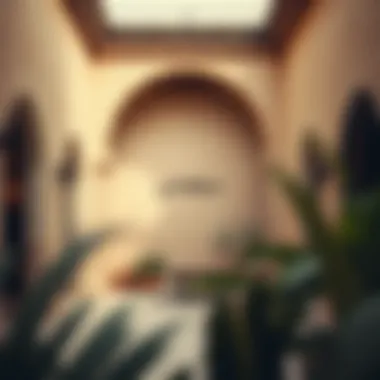

Palm Frond
The use of palm fronds speaks to the UAE's cultural identity and historical reliance on natural resources. Traditionally used for roofing, palm fronds are a lightweight and flexible material. They provide effective insulation while allowing for ventilation, a necessary feature in an arid environment. The characteristic smell of palm fronds can evoke nostalgia and represent a connection to a simpler lifestyle.
However, they do have a shorter lifespan compared to other building materials and require frequent replacement, which can pose challenges for preservationists aiming to maintain authenticity in restoration projects.
Common Design Elements
Wind Towers
Wind towers or barjeel, are ingenious structures that embody the spirit of traditional Emirati architecture. Their primary purpose is to catch and direct winds into living spaces, effectively cooling homes long before the advent of modern air-conditioning. This passive cooling technique showcases a deep understanding of local climate conditions and the skill of architects of the past.
Wind towers are not just functional; they are iconic symbols of the architectural identity of the UAE, often adorning the skyline of historic districts. Their design can vary significantly, with each region having its stylistic flair. Despite their advantages, the wind towers require careful design and placement to be effective, which can complicate restoration efforts.
Courtyards
Courtyards serve as central gathering spaces in many old Emirati houses, embodying the cultural practice of community and family living. These open-air elements facilitate natural light and air circulation, enhancing comfort in the heat. Often surrounded by rooms that face inward, courtyards also provide privacy, allowing families to enjoy the outdoors while remaining sheltered.
In terms of aesthetics, courtyards can be adorned with beautiful greenery or water features, contributing to the house's overall serenity. However, they can also present challenges for maintaining traditional aesthetics while integrating modern functionalities, such as drainage.
Mashrabiya
Mashrabiya, the intricately carved wooden latticework, represents a quintessential design feature in old houses. This architectural element served to maximally utilize breezes while providing privacy, allowing residents to observe the exterior without being seen. The craftsmanship involved in creating these beautiful screens reflects a level of artistry that is deeply ingrained in Emirati culture.
While mashrabiya is visually captivating, they also require diligent upkeep since wood can deteriorate over time, especially in humid conditions. Nevertheless, their unique beauty and functionality continue to inspire architects today, reminding us of the rich heritage embedded in these traditional homes.
Symbolism and Aesthetics
The symbolism infused in the architecture of old Emirati houses is profound. Every design choice, right from the materials used to the layout, reflects the values and lifestyle of the people. The aesthetic appeal of these houses is rooted in their cultural significances, evoking sentiments of home, family, and collective memory. Engaging with these elements allows one to appreciate not just the visual beauty but the storytelling aspect of architecture.
Prominent Regions with Old Houses
The old houses in the UAE are more than just structures; they are touchstones of a nation's history and identity. Each region embodies distinct architectural features and traditions, reflecting the various influences and circumstances that have shaped Emirati culture over the centuries. By investigating the prominent regions where these old houses stand, we gain insights into the unique narratives, social practices, and innovations surrounding each area. This section emphasizes the importance of these regions in not just preserving the past but also in informing future generations about the roots of Emirati identity.
The Heritage of Dubai
Dubai, a city synonymous with modernity, has roots deeply embedded in its historical neighborhoods. Areas like Al Fahidi and Al Seef offer a glimpse into the city's past. The narrow alleyways are home to traditional wind-tower houses, which served as natural air conditioning long before the advent of modern technology. This stands as a testament to the ingenuity of Emirati architecture.
The Dubai Museum, housed in Al Fahidi Fort, showcases artifacts and exhibits that narrate the story of the region’s growth from a small fishing village to a bustling metropolis. One can appreciate how the craftsmanship in these old houses corresponds with local environmental conditions and materials used, such as coral and mud, much like those in traditional houses across the region.
Cultural Significance in Abu Dhabi
Abu Dhabi, the capital, carries its own architectural narrative. The old houses in areas like Al Ain reflect a more traditional lifestyle, harmonized with the surrounding desert landscape. These homes, adorned with intricately carved wooden doors and spacious courtyards, provide insights into the communal lifestyles of early Emirati families. This architectural style not only signifies shelter but also community bonding, as courtyards often served as social spaces.
Although modernity is creeping into the fabric of Abu Dhabi, there’s an ongoing effort to preserve these cultural touchpoints. By recognizing the significance of older architecture, the government and local organizations are ensuring that the stories embedded within these walls are not forgotten. The combination of modern urban planning with heritage preservation efforts demonstrates a balanced approach to development.
Old Houses in Sharjah and Ajman
When one shifts focus to Sharjah and Ajman, there's a noticeable shift in atmosphere and architectural style. Sharjah is often deemed the cultural capital of the UAE for good reason. The emirate prides itself on maintaining its historical sites, including a collection of beautifully restored houses that showcase Islamic and local artistry.
In Sharjah, the old houses, especially in the Al Mahatta area, serve as living museums. Their designs often feature elaborate stuccos and vibrant colors, distinct from the simplicity found in other regions. Ajman adds to this narrative with its coastal old houses that reflect a lifestyle closely tied to the sea. The historical significance of fishing and pearling comes alive in the design of these buildings.
Thus, Sharjah and Ajman exemplify how local traditions intertwine with architectural expressions, forming a rich tapestry of history that continues to educate and inspire future generations. Collectively, as we dive into each of these regions, it becomes evident that the old houses tell a story—one that bridges the ancient with the modern, ensuring that cultural identity thrives.
"Old houses are not just relics; they are the keepers of our stories, reminding us of who we are and where we come from."
Preservation and Restoration Efforts
Preserving the architectural heritage of old houses in the UAE is about more than just maintaining structures; it is about safeguarding stories and the cultural identity of a nation. These houses provide a tangible link to the past, showcasing traditions, craftsmanship, and architectural techniques that define Emirati culture. Efforts in preservation and restoration serve several vital purposes. They protect both history and the environment, enhance community pride, and offer educational opportunities for future generations. Without these efforts, many valuable heritage sites risk falling into disrepair, rendering significant portions of Emirati history invisible.
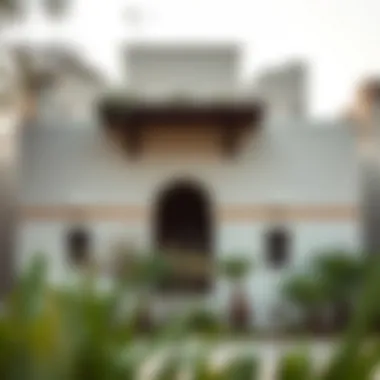

Government Initiatives
The government of the UAE has recognized the intrinsic value of its architectural heritage and has taken significant strides to bolster preservation initiatives. Various agencies, such as the Abu Dhabi Department of Culture and Tourism, play a crucial role in implementing laws aimed at protecting historic sites.
One key initiative is the Heritage Village project, which aims to restore and revive old houses, incorporating modern technology while respecting traditional design aspects. These restorations aren't mere facelifts; they are comprehensive endeavors that often involve meticulous research to ensure authenticity.
Similarly, the Dubai Culture and Arts Authority orchestrates programs designed to foster awareness about Emirati heritage. By collaborating with architects and historians, they set standards for restoration practices. Grants and financial incentives are also offered to homeowners willing to undertake restoration projects, thus encouraging private participation in preserving collective memory.
Additionally, government campaigns highlight the importance of architecture within the national narrative. For example, events like UAE Heritage Week focus on exhibitions and workshops that draw attention to traditional craftsmanship, increasing public interest and support for preservation efforts.
Community Involvement in Heritage Conservation
Grassroots involvement in preserving the architectural legacy of old houses is equally paramount. Local communities act as the frontline defenders of their heritage. When citizens take an active role in conservation, it breeds a sense of ownership, ensuring that preservation efforts are not externally imposed but organically nurtured.
Various NGOs and community organizations, such as the Emirati Heritage Association, work tirelessly to engage local populations in conservation projects. They often organize gatherings that celebrate traditional practices, integrating younger generations into the process. For instance, workshops on techniques like palm weaving and adobe building bring families together, imparting knowledge that might otherwise fade away.
In addition, community-led initiatives often underscore the social and cultural relevance of these houses. Local festivals promote the historical contexts of these buildings, transforming them into living museums that can educate and inspire.
The challenges faced by these grassroots efforts include funding and governmental partnership. But when communities partner with local authorities, the outcomes can be remarkable. As an example, initiatives have sprung up in neighborhoods like Al Fahidi, where community members help to curate exhibits in restored heritage houses, breathing new life into these spaces that tell their stories through both architecture and activities.
Community involvement transforms preservation into a collective journey, strengthening both identity and heritage.
Challenges Facing Old Houses Today
Old houses in the UAE are not just structures; they are living testaments to the country's rich history and cultural identity. However, these valuable assets face several challenges in today's rapidly evolving landscape. Understanding these concerns is essential to appreciate the complexities of preserving architectural heritage while accommodating modern needs.
Urbanization and Its Impact
As the winds of urbanization blow stronger across the UAE, old houses find themselves in the crosshairs of relentless development. Cities like Dubai and Abu Dhabi are witnessing a surge in modern skyscrapers and commercial complexes, which often come at the expense of historical sites.
The allure of new development can make the older homes seem less appealing, primarily due to the perceived inefficiencies linked to traditional structures. Thus, many owners are compelled to raze these buildings to make way for new developments, which can lead to a significant loss of cultural heritage. The charm of old neighborhoods slowly diminishes, replaced by concrete and glass.
"The march of modernity often leaves the past in the dust, making it difficult for communities to preserve their identity."
A major issue linked to urbanization is the shift in community demographics. As more expatriates move in, the distinct characteristics of neighborhoods can blur. The vibrant cultural tapestry that once thrived around traditional homes gives way to a more homogenized existence. This can diminish the appreciation for local history among the younger generations, who may not connect with the past as deeply.
Climate Change and Material Degradation
On another front, climate change poses a formidable threat to the integrity of old houses. The UAE's climate is characterized by intense heat and humidity, which can accelerate the degradation of traditional building materials. Structures built with coral stone or adobe, famed for their insulation properties, can become vulnerable over time if not maintained properly.
Changes in weather patterns, such as increased rainfall or extreme heat, not only affect the physical structures but also challenge preservation efforts. For instance, heavy rains can lead to erosion and damage roofs, which are often made of palm fronds and other organic materials. The need for constant repairs can place a financial burden on owners, many of whom struggle to maintain these structures amidst modern demands.
To counteract these threats, innovative restoration techniques must be explored to integrate modern resilience strategies while respecting the essence of traditional architecture. Balancing the need for maintenance with historical fidelity becomes a challenging tightrope to walk.
In summary, the challenges of urbanization and climate change are significant hurdles in preserving old houses in the UAE. By addressing these concerns thoughtfully, we can work toward a future where the past is honored alongside the present.
The Role of Old Houses in Modern Society
The old houses scattered throughout the UAE are far more than just mere relics of the past; they represent a unique confluence of cultural identity, tradition, and the evolving landscape of modern society. These structures provide a tangible link to the historical narrative of the Emirati people. They encapsulate values that are often overshadowed by swift urbanization and modernization. Understanding how these heritage sites function in today’s world unveils their significance in fostering a sense of belonging and continuity within the nation.
Cultural Identity and Heritage Tourism
Cultural identity is deeply rooted in the architecture of old houses. They stand as proud symbols of the heritage and traditions of the regions they inhabit. For many Emiratis, these houses are a source of nostalgia and pride. They remind them of their forefathers’ way of life, their customs, and their values. As such, they contribute to the communal identity that unites citizens in a rapidly changing society.
Moreover, these structures have become focal points for heritage tourism in the UAE. Visitors from across the globe flock to experience the rich tales these old stones have to tell. Places like Al Fahidi District in Dubai and Al Ain's traditional neighborhoods often teem with tourists eager to get a glimpse into an era long gone. Tour companies and cultural programs are leveraging this interest by organizing guided tours, exhibitions, and workshops highlighting the architectural nuances and cultural significance of these dwellings. The number of tourists in these areas is on the rise, presenting economic opportunities through heritage tourism that benefits the local community.
"Old houses are not merely buildings; they are carriers of stories that bind generations together."
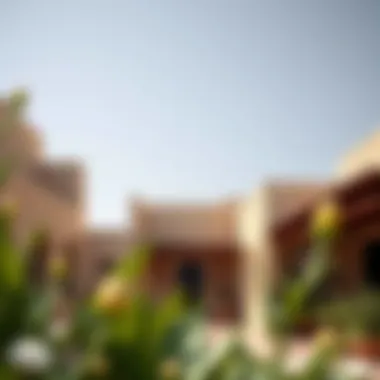

Additionally, heritage tourism doesn't just cater to visitors; it ignites curiosity among the local population as well. Emiratis, especially the youth, are increasingly taking an interest in their architectural heritage. This connection fosters a sense of responsibility for their preservation, motivating individuals and communities to engage in conservation efforts.
Educational Value and Public Awareness
The educational aspect of old houses is paramount. They serve as live classrooms where history comes to life, offering insights into traditional building techniques, local materials, and the socio-economic conditions of the past. For students and researchers alike, these houses are invaluable resources that enrich the understanding of Emirati history and culture.
Moreover, showcasing these structures can inspire programs that educate the public on sustainable living practices, particularly relevant in today’s context of climate change and resource management. Wood, thatch, and stone were once the mainstays of construction. They have a lesson to impart on future generations regarding modern architectural practices that respect and incorporate natural resources.
Community events, school field trips, and workshops lead by local historians are avenues to enhance public awareness. Initiatives like the Sheikh Mohammed Centre for Cultural Understanding play a paramount role in fostering dialogue about heritage preservation. By engaging the younger population with hands-on experiences in these historic sites, the message of conservation is passed on effectively.
Comparative Analysis with Other Regions
The significance of examining the architectural heritage of old houses in the UAE alongside that of other regions offers a rich ground for understanding the uniqueness of Emirati structures. Such comparative analyses deepen our appreciation for local styles, materials, and techniques while also highlighting common threads woven through various cultures. They allow us to explore architectural evolution and the influences that have shaped housing designs, materials, and technologies across different contexts.
By comparing traditional Emirati houses to others in the Arabian Peninsula and beyond, we gain valuable insights into the shared heritage and divergent paths nations have embarked on throughout history. This understanding serves multiple purposes:
- Recognition of Common Roots: Many societies face similar environmental challenges and sociocultural conditions, leading to analogous architectural solutions. Exploring these commonalities helps experts identify geographical adaptations to climate and available resources.
- Architectural Exchange: Historically, regions have influenced one another through trade routes and migration. Analyzing these dynamics sheds light on borrowed techniques, styles, and designs that have been integrated into local traditions.
- Inspiration for Preservation: Learning from the successes and failures in conserving heritage from other regions can illuminate potential strategies for safeguarding the UAE’s architectural gems.
“You can't know where you're going until you know where you've been.” This quote poignantly illustrates the reason behind comparative studies—they serve as a roadmap in future preservation strategies by reinforcing both the identity and unique character of Emirati architecture.
Traditional Houses in the Arabian Peninsula
When considering traditional houses in the Arabian Peninsula, similarities often stand out—be it in general layout, materials used, or design strategies. These homes share a critical foundation in the environmental context of being situated in arid, hot climates. For instance:
- Adobe and Stone Construction: Many houses utilize locally sourced materials like adobe blocks and stone, reflecting a pragmatic approach to dealing with the natural elements. It is fascinating to see how the use of such materials varies, yet the principle remains the same across Qatar, Oman, and Saudi Arabia.
- Wind Towers: A common feature is the wind tower or barajeel, used to naturally ventilate homes during the hot summer months. This architectural element demonstrates an ingenious integration of environmental design that enhances comfort without reliance on modern technology.
- Courtyards: Traditional layouts often incorporate central courtyards, creating shaded outdoor spaces where families can gather. This shared living environment fosters community and enhances social ties, essential in Arab culture.
Through acknowledging these elements, one can see how traditional houses create a sense of belonging, laying the groundwork for community cohesion in the Arabian Peninsula.
Lessons from International Heritage Practices
Looking beyond the Arabian Peninsula, an exploration of international heritage practices reveals various methodologies in preserving old houses. The lessons learned can be transformative, enabling enhancements to local practices:
- Community Engagement: Many successful preservation efforts internationally emphasize local involvement. Experts frequently note that involving residents in the preservation of their heritage cultivates stewardship and personal investment in the process.
- Adaptive Reuse: The trend of adaptive reuse—transforming old buildings for modern purposes—has gained popularity around the globe. This practice respects historical integrity while injecting new life into otherwise neglected properties.
- Policy and Support: Countries like Italy and France illustrate the importance of supportive governmental policies. They have frameworks that ensure funding and technical assistance are available for historical renovations.
The UAE could greatly benefit from these insights, tailoring them to fit its unique cultural palette and architectural needs. By synthesizing local practices with global examples, the future of old houses in the UAE stands to become increasingly robust and resilient.
For more information, consider exploring resources like Wikipedia on Traditional Architecture or Britannica's Architectural Insights.
Future Prospects for Old Houses
The future of old houses in the UAE is a compelling topic that seamlessly bridges the past and present whilst paving the way for sustainable practices and cultural preservation. As urban landscapes rapidly evolve, these historical structures stand as embodiments of the Emirati identity, needing careful consideration to preserve their essence while meeting contemporary demands.
One key aspect of the future prospects for these houses involves addressing the balance between preservation and modernization. Architects and heritage experts are increasingly leaning towards innovative restoration techniques that respect traditional craftsmanship while implementing modern technology. They recognize that safeguarding architectural heritage needn’t shield it from modern enhancements but rather integrate it. Such approaches are crucial for appealing to homeowners and investors who might shy away from properties perceived as outdated.
Innovative Restoration Techniques
The revival of old houses in the UAE hinges significantly on employing innovative restoration techniques that merge historic authenticity with modern conveniences. This blend ensures sustainability while also appealing to a new generation of homeowners who appreciate the past but require the functionality of the present. Some notable techniques include:
- Use of Eco-Friendly Materials: Restoration projects now often utilize sustainable materials that mirror the original construction. For instance, employing reclaimed wood not only avoids deforestation but also breathes new life into aged structures.
- Application of Modern Technology: Techniques such as 3D printing may assist in replacing missing architectural elements without compromising the integrity of the design.
- Energy Efficiency Enhancements: Updating insulation and installing energy-efficient windows help in maintaining the original aesthetics while making the homes livable and environmentally friendly.
These innovative techniques not only breathe life into these old houses but also ensure they remain relevant and functional, which is integral for inviting new generations to appreciate their historical significance.
Integrating Modern Living with Heritage
Modern living necessitates certain conveniences, but this need should not eclipse the rich heritage embedded in the old houses across the UAE. Finding a way to marry contemporary lifestyles with traditional architecture can greatly enhance both the cultural and real estate landscape of the country. Here are some considerations for achieving this integration:
- Flexible Spaces: Designers can create layouts within these old structures that accommodate modern family needs without losing the essence of the home. For instance, repurposing a traditional courtyard into an open-plan kitchen or living area balances both space and tradition.
- Tech-Enhanced Living: Integrating smart home technology discreetly into historical homes could enhance comfort while maintaining the aesthetic character. For example, implementing smart thermostats or lighting systems that blend seamlessly into the architectural style.
- Community-Focused Initiatives: Encouraging communal areas that celebrate the heritage can invite not just homeowners but also visitors to engage and learn about the cultural significance of these homes, ensuring that they are not seen merely as relics, but vibrant parts of modern life.
"Embracing the old while welcoming the new not only preserves our history but enriches our future."
By innovatively restoring and smartly integrating modern comforts into old houses, the UAE can establish new paradigms for heritage conservation that honor tradition while welcoming progress. The careful interplay of these elements will ensure that the architectural heritage continues to thrive, reflect the nation’s pride, and hold significant value for years to come.
For more insights on architectural practices, you might explore resources like Britannica or Wikipedia.
Additionally, for the latest updates and discussions on heritage sites, visiting platforms such as Reddit or relevant community pages could provide interesting perspectives.






